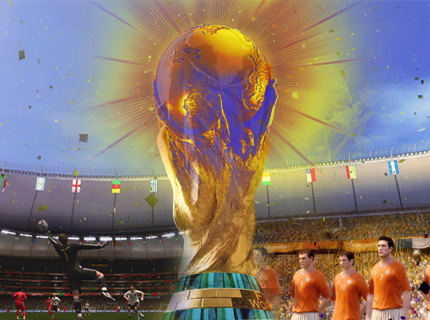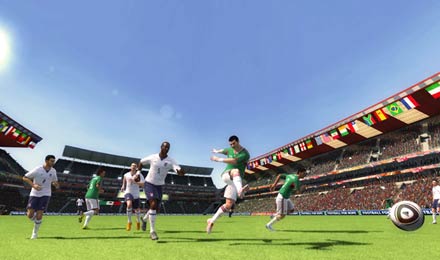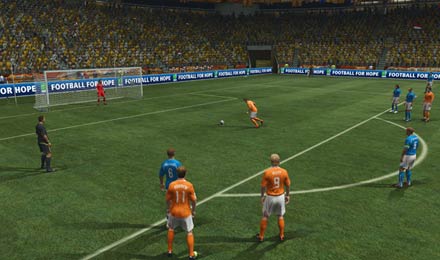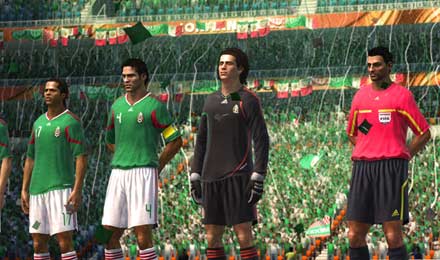2010 FIFA World Cup South Africa from EA Sports is a game which focuses on the upcoming footie tournament in South Africa. It is the official video game for the 2010 FIFA World Cup and features all of the 199 teams that took part in the qualification. Available for the PS3, Xbox 360, PSP, Wii and the iPhone, the game immerses players in the intensity of the international football competition.

Let’s jump right into gameplay in 2010 FIFA World Cup South Africa which is pretty much the same as that in FIFA 10, with a few marginal upgrades that strive to pump in a greater degree of realism and added excitement of playing football on the world stage, but fail almost miserably.
Some additions to the gameplay are welcomed while others just prove a hindrance. Playing at high altitudes increases the fatigue rate of your players, especially if they are not used to playing at that altitude. What EA Sports failed to account for is the fatigue feature of players from countries at low altitudes, who play for clubs and subsequently train, at high altitudes. Home ground advantage cannot be counted out in the game, making it critical to get the best results at home so that you don’t have to rely heavily on away games to turn the tide in your favor.
The only worthy difference between 2010 FIFA World Cup South Africa and FIFA 10 lies in the taking of penalty kicks. You now have an oscillating needle which determines the player’s composure when taking a penalty kick. You need to stop it in the green in order to take a pristine penalty. Get it in the yellow and your player’s composure is affected leading to possible error. This doesn’t affect a straight forward kick, but if you’re cheeky enough to try to chip the keeper even the slightest deflection from green can be disastrous. Put the needle in the red and you’re done for. Interesting mess-ups are generated from such penalty kicks, such as powering the ball way off target, giving away your intentions, and even losing your footing just as you are about to take the kick.
The best thing about the penalties though is the ability to take one in Cristiano Ronaldo-style. The game commentator calls it a “stutter shot”. You have to press the shoot button to stop the oscillating needle where you want it, holding it down for a longer duration of time for more power, whilst also giving direction. In order to take a stutter shot, you have to press the shoot button once more, in your run up to the kick. Doing so, your player will pause or slow down for a short period of time before letting loose his penalty kick. This time allows you to judge which side the keeper might be heading, giving you the chance to change your ball positioning to correct for this. The power of a stutter shot gets considerably diminished, making it more likely a keeper will save it if he gets close enough to the ball.
The keeper also behaves more “intelligently” in penalties, and getting the ball anywhere close to his arms or legs will open up the possibility for him to stretch out and save it. The keeper can decide which direction he wants to go early on, in which case if the penalty taker decides to do a stutter shot he might be able to gauge this, putting the ball out of reach of the shot stopper. Alternatively the keeper can decide to wait for the very last moment, attempting to pull off a reflex save after the kick has been taken. Whether he saves a kick in this instance depends on his shot stopping abilities and reflexes, as well as the kick takers abilities.

With regards to gameplay, 2010 FIFA World Cup South Africa introduces a whole new control system targeted mainly at new and less experienced FIFA players. Called the two-button control system, it allows players to do almost everything during a match using just the pass and shoot button from the Classic controller layout. How long you hold down the pass button determines the type of pass executed, such as a simple ground pass or a chipped pass. The computer makes calculations when attacking and defending, leading to through-balls and defensive clearances. While shooting as well the computer makes most of the decisions and you just have to get the angle and power to your liking. You can also opt for the conventional control system of course, and this is just an added option.
Another new feature, well mini-feature, you have in 2010 FIFA World Cup South Africa is score updates from other games. While you’re playing a game in the “2010 FIFA World Cup” mode, which is basically the manager mode in the game, you receive information about the latest scores of other matches taking place. Even the commentary has been updated, and the commentators will mention a line or two about the other games going on. This would have been a really amazing feature if it would have carried more weight. Of course, international qualifiers are scheduled at different times, so the full intensity of live score updates does not come through. This gives a very hollow and unauthentic angle to the game. When playing on such a huge stage with the eyes of the world watching, every bit more needs to be done to capture the excitement.
One thing in the manager mode equivalent of the game is that you pick up far too many injuries. And most of them don’t even occur during matches. You simply receive a notification that a player has been injured. This could have you missing many of your best in-form players as you make your bid for one of the world’s most coveted trophies. You are forced to replace the injured players with less talented individuals who might be down on form. This high incidence of injuries can really bog your campaign. We battled with England all the way to the final of the World Cup, knocking out Argentina, Mexico and Spain, only to have Rooney, our most prolific goal scorer, injured. He missed the final but Crouch and Defoe pulled it together for queen and country. Also when a player is injured, he remains out for a certain number of “games” and not weeks. This is where the EA Sports game gets it totally wrong, considering that qualifying is held over a period of many months if not years. And the player only returns after that many games, even if those games are played out over a span of a few months.
Equivalent to the Be A Pro mode that EA Sports had in FIFA 10, the Captain Your Country or CYC mode in 2010 FIFA World Cup South Africa lets you play as a single player through the entire campaign. But the twist here isn’t just that the stage is simply a much larger one. The rabbit hole goes a little deeper than that. First off, don’t expect to jump right into the first team. You start your international career sidelined due to whatever reason, and have to prove yourself to your manager in order to gain a first team spot in the national team. Here’s where a new facet of the game of football comes to light. You have a CYC ranking throughout your international career which changes during the course of the campaign based on your performance. In each match you play, the manager keeps an eye on your performance as well as the performance of three other players who rank in and around your CYC rank range. These guys are your competition. The more passes you complete, shots on goal you are brave enough to take, successful tackles you perform, and of course goals you score, the higher your match rating gets. Impress the manager by putting in an inspired performance to climb up the ranks playing as a B International, making it onto the fringe, and finally breaking into the first team. Become the top ranked player to receive the captain’s arm band; every player’s dream. Once you become the captain a lot more decisions open up to you and you can choose whom you want to put on corner, free kick and penalty kick duty.

Story of qualifying is a new mode which allows you to jump back in time and attempt to change the outcome of some big real-world games in the qualifying rounds. Various objectives and scenarios out of real-world games are thrown at you in this mode. For example, if a nation has scored late on to take the lead, with only a few minutes left you must attempt to pull things around, and maybe even score two or more while not conceding. An interesting feature this, it definitely boosts the game. You should begin to dabble in this mode when 2010 FIFA World Cup South Africa starts to get a little drab.
The inclusion of the likenesses of real life managers in 2010 FIFA World Cup South Africa is another nice feature. You get the managers running up and down the touchline, jumping about, barking out orders at their players, instructing substitutes what to do, and looking on in anguish as their team falls further behind. The manager animations/cut scenes seem a little too detached though; and unnecessary at times.
Another issue we had with the game was that many-a-times when you play a lobbed through ball to an attacker in space, the player won’t bring the ball down with his head. He runs in front of the ball’s path and waits for it to stop bouncing as much, before attacking it or moving to bring it under control. This can seriously hinder the fluid gameplay experience when you’re looking to raise the pace of the game. Both attacker and defender will stand and watch as the ball slows down, allowing the defending team to get back and take up position.
2010 FIFA World Cup South Africa is much more fun when played with a group of friends with varied international loyalties. Making the football experience interactive and fun is something that the game easily and quickly achieves. And when everybody is into it, the intricacies and minor faults of the game are shrugged off.

Player celebrations have been designed to reflect the atmosphere of playing and scoring at the international level. They capture the elation of achieving something that every football player the world over dreams about. During celebrations the camera comes to life moving across the celebrating player. What’s missing though is a camera pan to the fans in the stadium to show them also celebrating with as much gusto.
The commentary in the game seems a step above that in FIFA 10, and the commentators recognize players’ and managers’ achievements. They even give a word or two of advice on other ongoing matches. This integration bodes well for EA Sports and delivers a slightly better experience overall.
So finally you’ve played through all the qualification matches, maybe even the international friendlies, and clawed your way through the competition. It’s the finals. The trophy is displayed. The players walk out. You see it from a million different angles. The managers shake hands. The camera runs through the players all lined up, geared up and ready for the match of their lives. It’s a really amazing feeling when you see the confetti fall, all the supporters cheering and the manager jump for joy. And when the captain lifts the World Cup trophy, that does it!
The Final Word: 2010 FIFA World Cup South Africa has a few interesting innovations in gameplay, and some which are quite puzzling and which you’d rather have left out. All-in-all though the game delivers a good enough simulation of international matches, especially if you’re just playing kick-off. The tiny bits of information about the nations, as well as the globe showing the countries as you select them are good additions/distractions to keep you engrossed in the fervor of the competition.
Graphics: 9.5/10.
Gameplay: 9.5/10.
Sound: 8.5/10.
Overall (not an average): 9.0/10.

